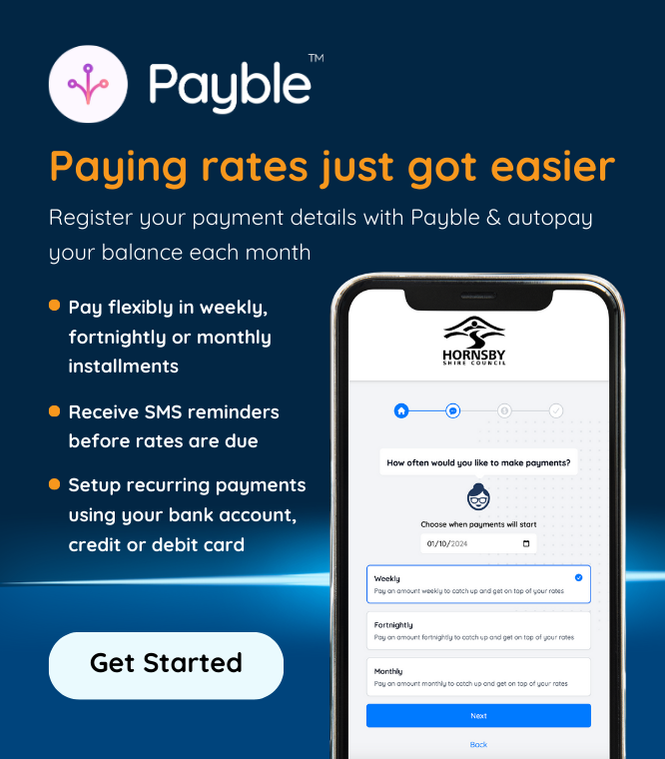Rates Information
The Valuer General supplies land values to councils to use in setting rates. Councils receive new land values for rating every three years. Rates are principally calculated by multiplying the land value of a property by a rate in the dollar, subject to a minimum/base rate payable.
In any year when new valuations apply to a local government area, the rate in the dollar has to be recalculated in relation to the increase/decrease in land values across the whole of the area. All councils in NSW are restricted by legislation, called rate pegging, as to the amount of increase in total rate income that can be applied each year.
The new Land Value that applies to any individual property may vary, and in many instances significantly, from the average land value increase across the local government area. This is the reason why rates can increase by larger, or smaller, amounts than the rate pegging percentage determined by IPART. This happens every time a new valuation is applied to a Council area.
In Hornsby area the rates levied consist of the following rate types:
- Ordinary Rate for Business, Business CBD – ad valorem (rate in the dollar) subject to a minimum.
- Ordinary Rate for Residential and Farm Land – ad valorem (rate in the dollar) subject to a minimum plus a base amount.
- Catchment remediation rate - ad valorem (rate in the dollar).
The rating category or sub-category is shown on your Rate Notice. Section 493 of the Local Government Act states that there are four categories of ordinary rates: Farmland, Residential, Mining and Business.
Council has to determine what "Rating Category" each rateable parcel of land is according to its dominant use. If you disagree with the categorisation of your land, you or your agent can ask for a review.
A request for a review must be in writing on an Application for Change in Category of Land Categorisation for Rating Purposes form. You can also contact Rates section sending an email to accounts@hornsby.nsw.gov.au or call us on 9847 6777 and ask for the form to be posted, or emailed to you.
If the category of your property is different to that shown on the Rate Notice, it is your obligation to notify Council of the correct category. If you are dissatisfied with Council's declaration of the category of your land after it has been reviewed, or the date the category of your land is to take effect, you may appeal to the Land and Environment Court within 30 days after the declaration is made, under Section 526 of the Local Government Act, 1993.
In general, Mixed Development rating allows for a property to receive a combination of Residential and Business rating categories (providing a form of rating relief - in most cases) due to the property having dual usage. The Local Government Act, 1993 provides for Mixed Development rating. A parcel of land occupied, or used solely as one building comprising a residence and a business, may be considered for Mixed Development rating, if it can be separately occupied for both business and residential purposes. The residential category and business category could be rated according to the proportion that each usage has to the whole of the property.
The Valuer General's Department supplies Council with a Mixed Development Apportionment Factor (MDAF), for land subject to Mixed Development rating. The MDAF is determined by calculating the proportion that the value of the business part bears to the value of the land as a whole. The result is expressed as a percentage. Rates and charges are apportioned according to the MDAF. If, for example, a parcel of mixed development land has an MDAF of 60%, rates and charges would be apportioned as Business 60% and Residential 40%.
Rates and charges are usually increased each year to offset the increased costs of providing services to the community.
Councils in New South Wales are restricted by legislation as to how much they can increase rates each year. The Independent Pricing & Regulatory Tribunal (IPART) assesses the increase in costs and determines the maximum percentage that rates can increase.
An increase in services costs includes:
- Materials for road making and other infrastructure provision, maintenance and repair.
- Equipment, plant and services purchase, maintenance and hire.
- Contracts and labour.
- Statutory charges paid to other levels of government and its instrumentalities.
- Other outgoings for finance, insurance and utilities costs etc.
The Catchments Remediation Rate (CRR) is levied at 5% of Council’s total ordinary rate revenue, on all properties throughout the Shire on an ad valorem basis.
All catchments impact on water quality and all rateable properties within these catchments benefit from the environmental and water quality improvements, in terms of improved quality of life for ratepayers. In 2023/24, the CRR yield was approximately $3.93 million.
Since July 1994, the CRR has generated over $55 million. These funds have been dedicated to improving water quality across the Hornsby Shire through a combination of both capital and non-capital works. Over 400 water quality improvement assets have been constructed and installed to date, preventing thousands of tonnes of pollution, including litter, sediment and organic matter from entering our waterways. In the past 5 years, almost 3000 tonnes of waste was removed from stormwater quality assets across the Shire.
The program also supports a number of pollution prevention initiatives such as environmental education, industrial auditing, street sweeping, and emergency spill response and pollution regulation.
Ongoing work funded by the CRR
In addition to the pollution treatment and prevention initiatives, the CRR funds ongoing works associated with the maintenance and monitoring of these assets and the receiving waterways. Through regular and proactive maintenance of water quality assets, Council can ensure the assets are operating to their full potential thereby resulting in a better environmental outcome.
Water quality monitoring data is collected using physical, chemical and biological indicators of waterway health. This data helps Council prioritise future remediation works, identify areas where environmental degradation is occurring and to assess long term water quality improvements.
Useful links
Get your rates notice sent to your email
Do away with paper rates notices and have them sent securely to your email.
Land values and council rates
How is your land valued? The NSW Valuer General has published a fact sheet to help you understand the land valuation system.









